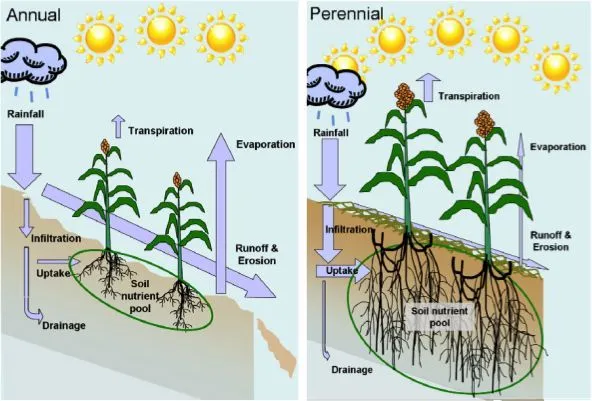Perennial Biomass Production
Perennial biomass production involves growing perennial plants for bioenergy, which can help reduce greenhouse gas emissions and improve soil health. This approach is crucial for sustainable agriculture and climate change mitigation.

Annuals vs. Perennials (Medium)
View open jobs in this Solution
Example Companies
- LanzaTech - Develops technologies for converting biomass into renewable fuels and chemicals.
- Solazyme - Specializes in algae-based biofuels and bioproducts.
- DuPont - Produces cellulosic ethanol and other bio-based materials.
- Monsanto - Develops genetically engineered crops for bioenergy.
- Syngenta - Provides seeds and crop protection products for biomass production.
Overview
Perennial biomass production involves growing perennial plants for bioenergy, which can help reduce greenhouse gas emissions and improve soil health. Over the past decade, significant progress has been made in developing perennial biomass production to reverse climate change. Breakthrough technologies such as cellulosic ethanol and algae-based biofuels have been developed and have contributed to the reduction of greenhouse gas emissions.
Progress Made
Significant advancements have been made in perennial biomass production:
- Cellulosic Ethanol: Produced from non-food plant materials, reducing competition with food crops.
- Algae-Based Biofuels: Algae can be grown on non-arable land and produce high yields of biofuels.
- Genetic Engineering: Developing crops with enhanced growth and biomass production.
- Nanotechnology: Improving the efficiency of biomass conversion processes.
- Synthetic Biology: Engineering microorganisms to produce biofuels and bioproducts.
Solutions by Sector
Biofuel Production
- Cellulosic Ethanol Plants: Facilities converting non-food plant materials into ethanol.
- Algae Biofuel Facilities: Cultivating algae for biofuel production.
- Integrated Biorefineries: Producing multiple bio-based products from biomass.
Case Studies:
- DuPont Cellulosic Ethanol Plant, Iowa, USA: World's largest cellulosic ethanol plant (DuPont). However, DuPont has faced criticism for its environmental practices and the sustainability of its biofuel production.
- Solazyme Algae Biofuels, USA: Produces algae-based biofuels and bioproducts (Solazyme). Despite its innovations, the scalability and economic viability of algae biofuels remain challenges.
- LanzaTech, USA: Converts biomass into renewable fuels and chemicals (LanzaTech). LanzaTech's technology is promising, but its reliance on industrial waste gases raises questions about long-term sustainability.
Agricultural Practices
- Perennial Grasses: Growing grasses like switchgrass and miscanthus for bioenergy.
- Agroforestry: Integrating trees and shrubs into agricultural landscapes for biomass production.
- Cover Cropping: Using cover crops to improve soil health and provide biomass feedstocks.
Case Studies:
- Switchgrass for Bioenergy, USA: Research on using switchgrass as a bioenergy crop (USDA). While promising, large-scale adoption faces land and water use challenges.
- Agroforestry Systems, Brazil: Integrating trees into agricultural systems for biomass and carbon sequestration (Embrapa). Agroforestry has multiple benefits but requires careful management to avoid negative impacts on local ecosystems.
- Cover Cropping for Biomass, USA: Using cover crops to improve soil health and provide biomass (NRCS). Cover cropping is beneficial but may not be feasible for all farming systems.
Technological Innovations
- Genetic Engineering: Developing crops with enhanced growth and biomass production.
- Nanotechnology: Improving the efficiency of biomass conversion processes.
- Synthetic Biology: Engineering microorganisms to produce biofuels and bioproducts.
Case Studies:
- Monsanto's Bioenergy Crops, USA: Developing genetically engineered crops for bioenergy (Monsanto). Monsanto's involvement in bioenergy is controversial due to its history of environmental and social issues.
- Syngenta's Crop Protection, Switzerland: Provides seeds and crop protection products for biomass production (Syngenta). Syngenta's practices have faced scrutiny for their environmental impact and reliance on chemical inputs.
- GreenPower International, Global: Develops biomass power plants worldwide (GreenPower International). GreenPower's projects are promising but require careful management to ensure sustainability.
Lessons Learned
- Location Selection: Choosing the right location with suitable climate and soil conditions is crucial for successful perennial biomass production.
- Environmental Impact: Consider the environmental impact, including land and water use, before large-scale implementation.
- Land and Water Requirements: Perennial biomass production requires significant land and water resources.
- Long-Term Investment: Perennial biomass production is a long-term investment that requires patience and commitment.
Challenges Ahead
- Land Availability: Finding suitable land for large-scale perennial biomass production is challenging.
- Water Scarcity: Perennial crops require more water than annual crops, and water resources are already strained in many regions.
- High Costs: Perennial biomass production requires significant initial investment and maintenance costs.
- Infrastructure Needs: Developing the infrastructure for collecting and transporting biomass feedstocks can be costly.
Best Path Forward
- Public Awareness: Increase awareness of the benefits of perennial biomass production among farmers, policymakers, and the public.
- Financial Incentives: Provide financial incentives to encourage farmers to adopt perennial biomass production practices.
- Research and Development: Invest in R&D to develop better perennial biomass production practices and technologies.
- Policy Support: Collaborate with governments to create supportive policies for perennial biomass production.
- Demonstration Projects: Establish demonstration projects to showcase the potential of perennial biomass production.
Prominent supporters include the Perennial Agriculture Consortium, the Soil Health Institute, and the Rodale Institute.
Image credit: Medium